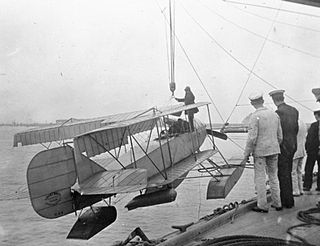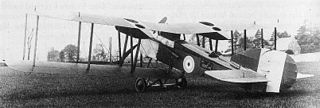
The Sopwith Tabloid and Sopwith Schneider were British biplanes, originally designed as sports aircraft and later adapted for military use. They were among the first types to be built by the Sopwith Aviation Company. The "Tabloid", so named because of its small size, caused a sensation when it made its first public appearance.

The Vickers F.B.5 was a British two-seat pusher military biplane of the First World War. Armed with a single .303 in (7.7 mm) Lewis gun operated by the observer in the front of the nacelle, it was the first aircraft purpose-built for air-to-air combat to see service, making it the world's first operational fighter aircraft.

The Bristol Scout was a single-seat rotary-engined biplane originally designed as a racing aircraft. Like similar fast, light aircraft of the period it was used by the RNAS and the RFC as a "scout", or fast reconnaissance type. It was one of the first single-seaters to be used as a fighter aircraft, although it was not possible to fit it with an effective forward-firing armament until the first British-designed gun synchronizers became available later in 1916, by which time the Scout was obsolescent. Single-seat fighters continued to be called "scouts" in British usage into the early 1920s.

The Blackburn TB was a long-range twin-engined anti-Zeppelin seaplane. It was Blackburn's first multi-engine aircraft to fly.

The Bristol T.B.8, or Bristol-Coanda T.B.8 was an early British biplane built by the Bristol Aeroplane Company and designed by the Romanian Henri Coandă. Fifty four Bristol T.B.8s were built, being mainly used as a trainer. A small number of Bristol T.B.8s were briefly used as bombers at the start of the World War I by the Royal Naval Air Service.
The Sopwith Admiralty Type 807 was a 1910s British biplane seaplane designed and built for the Admiralty by the Sopwith Aviation Company.
The Sopwith Two-Seat Scout was a 1910s British biplane Anti-Zeppelin scout biplane designed and built for the Admiralty by the Sopwith Aviation Company. It was nicknamed the Spinning Jenny due to a tendency to enter a spin.
The Westland N.1B was a prototype British single-engined floatplane fighter aircraft of the First World War. The first aircraft to be designed by Westland Aircraft, it was a single-engined tractor biplane. Despite good performance, only two aircraft were built, the Royal Naval Air Service operating landplane fighters from ships instead.

The Vickers E.F.B.7 was a prototype British fighter aircraft of the First World War. A twin-engined biplane, the E.F.B.7 was unsuccessful, only a single example being built.
The Vickers E.F.B.8 was a prototype British twin-engined fighter of the First World War. It was abandoned after only one aircraft was built, single-engined fighters being considered to have superior manoeuvrability.

The Vickers E.S.1 was an early British Fighter aircraft of the First World War. A single-seat biplane, only three E.S.1s were built, although at least one was used by a home defence squadron of the Royal Flying Corps.
The Sopwith Gunbus was a British fighter aircraft of the First World War. It was a single-engined pusher biplane based on a floatplane built by Sopwith before the war for Greece. Small numbers were built and used by the British Royal Naval Air Service, mainly as a trainer.

The Royal Aircraft Factory N.E.1 was a prototype British Night fighter of the First World War. A single-engined pusher biplane, it was a development of the Royal Aircraft Factory's earlier F.E.9 fighter, but was not successful, only six being built.
The Sopwith Three-seater was a British aircraft designed and built prior to the start of the First World War. One of the first aircraft built by the Sopwith Aviation Company, it was operated by both the Royal Naval Air Service (RNAS) and the Royal Flying Corps (RFC), being used briefly over Belgium by the RNAS following the start of the War.

The Short S.41 was a British single-engined biplane built for the Royal Navy in 1912. Capable of being operated either on wheels or floats, it was successful enough for a further two similar aircraft to be built, with the type remaining in use until the early years of the First World War.

The Short Admiralty Type 81 was a series of British two-seat floatplanes built prior to the First World War, and used by the Royal Naval Air Service in the early years of the war. They were powered by 160 hp (120 kW) Gnome Lambda-Lambda 14 cylinder two-row rotary engines and had folding wings to aid storage on ship, hence the popular name Short Folder, shared with a number of other seaplanes made by Short Brothers.
The Sopwith Admiralty Type C was an early British seaplane designed and built by Sopwith Aviation to drop torpedoes. A single engined tractor biplane seaplane, three were delivered to the Royal Navy in November 1914 but proved unable to lift a torpedo.

The Robey-Peters Gun-Carrier was a British three-seater armed tractor biplane designed and built by Robey & Company Limited at Bracebridge Heath, Lincoln for the Royal Naval Air Service (RNAS).

The Hamble River H.L.1 Seaplane was a British pusher biplane seaplane designed by Frank Murphy and built by Hamble River, Luke & Co Limited at Southampton.
The Sopwith Sociable was a British single-engined two-seat tractor configuration biplane designed and built by Sopwith for the Royal Naval Air Service.












